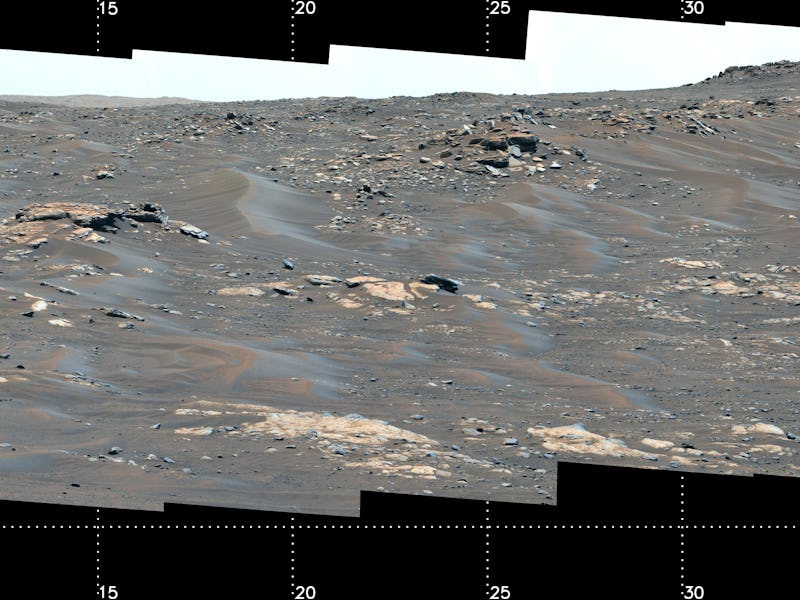New Mars study holds clues to how life began on Earth
Analysis of a 4 billion year old meteorite revealed clues on the history of the Red Planet.

Andrew Steele has been studying the Allan Hills Martian meteorite for 25 years. The enigmatic rock with strange structures contained inside led to a statement from then-President Bill Clinton on the possibility that they were formed by ancient microbes on Mars. But since then, the rock has been shrouded in controversy.
“I’ve done so many techniques with this meteorite, it’s unreal,” Steele tells Inverse. “As my understanding of Allan Hills has evolved, my understanding of science has evolved, so I feel that kind of student relationship, ‘okay, what are you going to show me today?’”
Through his latest probing of the meteorite, the Carnegie Science astrobiologist found evidence of organic chemistry that may have taken place on Mars billions of years ago which could also hold clues to how life on Earth may have originated.
The study, published Thursday in the journal Science, suggests that organic molecules found in the Martian meteorites may have been produced through a chemical reaction that does not involve life.
The Allan Hills meteorite 84001 has proven a source of controversy since the discovery 26 years ago that it contained these strange structures.
This recent suggestion does not exclude life on Mars, but suggests a new explanation for organic molecules found on the Red Planet. It also helps scientists better understand how these chemical reactions could have been a precursor for life on Earth.
WHAT’S NEW — The Allan Hills meteorite was found in the Allan Hills in Antarctica in December 1984. The meteorite is believed to have originated on Mars, dating back about 4 billion years.
“I decided to look more into the context of the rock itself,” Steele says.
Steele was performing spectroscopy imaging on the meteorite when he began picking up a carbon signal, which meant that carbon may be nestled within the rock. He then started to cut out some of the areas where the signal was coming from, and used a focused ion beam to cut out tiny samples and thin them so that he was able to look through them with a high-resolution microscope.
Through that process, Steele was able to analyze the elements and minerals of the meteorite.
“Some of our measurements showed new functionality that we hadn’t seen before,” Steele says.
After examining the meteorite, Steele and his team determined that the organic molecules found in Allan Hills likely formed through an organic chemical reaction as rock interacted with water on Mars.
“What is happening is as the silicate in the rock weather, they interact with brine [salt water] and they start to dissolve or weather back,” Steele says. “During that process, they actually produce hydrogen and that hydrogen can combine in that environment with Co2 to produce hydrocarbons with some oxygen functionality.”
And those are the organic molecules that were previously detected in the meteorite.
This ESA image of Eos Chasma shows the region where the rock is believed to have originated.
HERE’S THE BACKGROUND — In 2018, NASA’s Curiosity rover found organic molecules in three-billion-year-old sedimentary rocks near the surface of Mars. Organic molecules are considered the building blocks of life on Earth, and are considered to be indicative of some sort of biological process on Mars. But this study suggests that the organic molecules on Mars may have been produced through abiotic synthesis, or without life.
However, this does not exclude life on Mars.
“I’m a biologist, so I assume there is no life and I try to disprove that hypothesis,” Steele says. “In all my studies, I have not been able to disprove that hypothesis.”
Steele, who is also a member of the Mars Curiosity and Perseverance missions, approached his latest work from the perspective of, “Isn’t this a cool observation in organic chemistry?”
While most scientists use Earth as an analog for life on Mars, Steele would rather use Mars as an analog for life on Earth.
“This observation is really important for us to know what was the chemistry going on earlier that enabled life to form,” Steele says.
WHAT’S NEXT — NASA’s Perseverance rover landed on Mars in February 2021, armed with a set of tools that will enable scientists to bring back a sample of Mars to Earth.
This sample will hold answers as to whether or not life ever existed on our neighboring planet.
“If there is no life on Mars, it is not a negative result,” Steele says. “If we’re seeing the kind of reactions that we’re seeing now, it really does tell us about early Earth.”
Different missions that have studied Mars have collected pieces of the puzzle of the planet’s early history in an attempt to paint a full picture of its habitable past. But as the discoveries come in, scientists are racking up more questions than answers to a rather complex picture of life on another planet, as well as life on our own planet.
“The exploration of Mars is not just a journey in ‘are we alone?’ it's also a journey in, ‘where did we come from?’” Steele says.
Abstract: Water-rock interactions are relevant to planetary habitability, influencing mineralogical diversity and the production of organic molecules. We examine carbonates and silicates in the martian meteorite Allan Hills 84001 (ALH 84001), using colocated nanoscale analyses, to characterize the nature of water-rock reactions on early Mars. We find complex refractory organic material associated with mineral assemblages that formed by mineral carbonation and serpentinization reactions. The organic molecules are colocated with nanophase magnetite; both formed in situ during water-rock interactions on Mars. Two potentially distinct mechanisms of abiotic organic synthesis operated on early Mars during the late Noachian period (3.9 to 4.1 billion years ago).
This article was originally published on